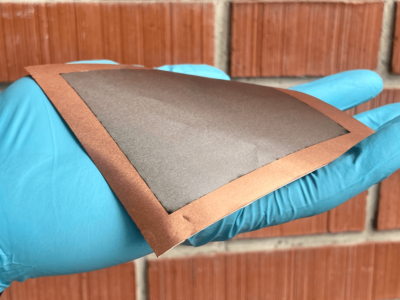
Wearable ultrasound patch monitors deep blood pressure
Their paper “Monitoring of the central blood pressure waveform via a conformal ultrasonic device” published in the Nature Biomedical Engineering journal reviews existing alternative, noting that today’s ultrasound instruments and methodologies for such monitoring are either cumbersome or result being uncomfortable for the patient.
Optical-based solutions such as photoplethysmography fail to detect arterial blood pressure but can only make measurements at the skin surface (peripheral blood pressure waveforms) and extrapolate from there, which hinders accuracy for cardiovascular disease diagnosis and prognosis.
As well as choosing to use ultrasonic waves which can effectively penetrate human tissues up to a depth of 4cm, the researchers focused their effort on making a wearable device that can flex and conform to the skin’s surface for better readouts, without relying on the gel typically used in ultrasound probes to achieve good acoustic coupling.
Only 240μm thick, their device hybridizes a 4×5 array of 0.9×0.9mm2 rigid piezoelectric transducer elements with soft structural components including meandering stretchable electrodes, the whole lot encapsulated with a silicone elastomer whose modulus is on par with that of human skin.

Because the patch is so thin, flexible and stretchable (with a reported elastic strain up to 30%), it can be softly laminated on the skin for optimum acoustic coupling.

of rigid piezoelectric transducers, each made of a
composite (periodic piezoelectric rods embedded
in an epoxy matrix), connected to top and bottom
meandering electrodes.
Each tiny piezoelectric transducer in the array consists of a composite (about 200μm thick) of piezoelectric microrods periodically embedded in a passive epoxy matrix. Working at a frequency of 7.5MHz, the transducers can be individually addressed by 20 stimulating electrodes on the top and a common ground at the bottom.
Beam forming techniques can be applied to map blood vessels’ positions deep under the skin, emitting ultrasound and detecting the reflection waves to make vessel diameter measurements (directly related to blood pressure).

in a deep artery or vein.
Credit: Chonghe Wang/Nature Biomedical Engineering.
Vessel diameter measurements performed with the ultrasound patch were validated by clinical ultrasonography.
“The device can capture the pulsating blood vessel diameter dynamically with high spatial (axial resolution of 0.77μm) and temporal (500μs) resolution” the authors wrote in their report, with a stable electrical performance under stretching and in a moist environment which makes the patch suitable for long periods of monitoring without any discomfort for the patient.
Related articles:
Plastic MEMS promises pervasive ultrasound imaging
Ultrasound sensor market set for take off
How about plastic MEMS?
3D printer outputs stretchable soft circuits hybridized with SMT parts
 If you enjoyed this article, you will like the following ones: don't miss them by subscribing to :
eeNews on Google News
If you enjoyed this article, you will like the following ones: don't miss them by subscribing to :
eeNews on Google News




